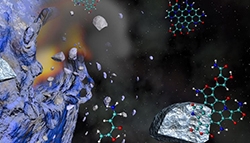LAB REPORT
Science and Technology Making Headlines
Oct. 18, 2019


El Capitan will be the National Nuclear Security Administration’s first exascale supercomputer.
Exascaling a mountain of data
The Department of Energy’s (DOE’s) Exascale Computing Project (ECP), Cray and the DOE laboratories that will house the nation’s first three exascale supercomputers -- Argonne (ANL), Oak Ridge (ORNL) and Lawrence Livermore (LLNL) -- have established National Exascale Day as a registered holiday to be celebrated annually today (Oct. 18).
Exascale is defined as a quintillion computations per second, and Exascale Day celebrates the scientists and researchers who make breakthrough discoveries with the help of some of the fastest supercomputers in the world. Exascale Day celebrates those who keep asking what if, why not and what’s next — with the advanced technology to attain the answers.
The Exascale Era will have a profound impact on nearly every aspect of our daily lives — from health care and manufacturing, to understanding new energy sources and the origins of the universe.

A representation of selective laser melting of a stainless steel cage. Residual stress is an important issue that requires in-depth understanding and careful control during selective laser melting.
Stainless steel stress test
The buildup of microscopic residual stresses that occur during the process of 3D printing metal parts can lead to deformation and even cracking in the part, complicating the printing process and resulting in defects that cause damage and part failure.
To develop a strategy for mitigating these tiny stresses, Lawrence Livermore National Laboratory researchers have combined synchrotron X-ray diffraction with computer modeling to better understand the link between residual stresses and the mechanical properties of 3D-printed 316L stainless steel.
Researchers looked at how “marine grade” stainless steel parts built through the laser powder-bed fusion metal 3D-printing process strained under tension and compression at a grain-level scale, comparing the experiments to computer models.
They found that microscale stresses have a profound impact on the yielding and work-hardening behavior (the ability of a metal to deform elastically and plastically to accommodate applied stresses) of 3D-printed 316L stainless steels, and that residual stresses cause differences in the material’s responses to tension and compression, an important factor for load-bearing applications and component designs.


A millimeter-scale structure with submicron features supports a penny on top of a reflective surface.
Getting faster by the femtosecond
Engineers at Lawrence Livermore National Laboratory and the Georgia Institute of Technology have developed a nanoscale 3D printing technique that fabricates small structures a thousand times faster than two-photon lithography (TPL) techniques, the conventional method of making nanoscale components.
The new parallelized technique, known as femtosecond projection TPL, can make parts with depth resolutions of 175 nanometers, which is better than established methods and can fabricate structures with 90-degree overhangs that can’t currently be made.
The technique could lead to manufacturing-scale production of bioscaffolds, flexible electronics, electrochemical interfaces, micro-optics, mechanical and optical metamaterial and other functional micro- and nanostructures.


Cometary impacts can produce complex carbon-rich prebiotic materials from simple organic precursors such as amino acids. Image by Liam Kraus/LLNL
Comets as jumper cables for life
Comets screaming through the atmosphere of early Earth at tens of thousands of miles per hour likely contained measurable amounts of protein-forming amino acids.
Upon impact, these amino acids self-assembled into significantly larger nitrogen-containing aromatic structures that are likely constituents of polymeric biomaterials.
That is the conclusion of a new study by Lawrence Livermore researchers who explored the idea that the extremely high pressures and temperatures induced by shock impact can cause small biomolecules to condense into larger life-building compounds.


Co-Optima, which includes LLNL researchers, are working to boost engine energy efficiency.
Giving engines a boost
A new Co-Optimization of Fuels & Engines (Co-Optima) report describes the top ten biofuel-derived blendstock candidates. These top candidates, when blended with petroleum and used in a boosted spark ignition (BSI) engine, will offer environmental benefits and boost energy efficiency, all while being available at a competitive price.
One of the first of its kind, this comprehensive systematic assessment includes a broad range of biomass-derived molecules and mixtures across many chemical families — more than 400 bio-derived molecules. This work will help the research community better understand the efficiencies that biofuels bring to the table and identifies the biofuels that enable more efficient engine design and operation.
The Co-Optima team includes experts from nine national laboratories: Argonne, Idaho, Lawrence Berkeley, Lawrence Livermore, Los Alamos, Oak Ridge, Pacific Northwest, Sandia National Laboratories and the National Renewable Energy Laboratory.





